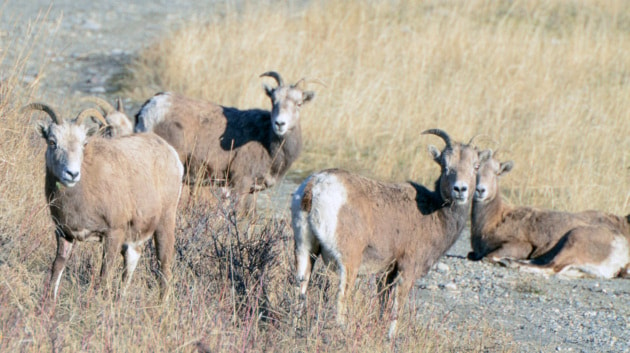A highly infectious disease affecting California bighorn sheep has now been found as far north as the Penticton Indian Reserve.
Psoroptes, or sheep mange, is caused by a mite which lives on the surface of the skin, particularly the ear canal, and can, if the problem becomes serious enough, lead to the death of the animal, especially if it spreads.
 In recent years psoroptes has been found in bighorn herds in the Ashnola-Similkameen populations, including the Snowy Protected Area.
In recent years psoroptes has been found in bighorn herds in the Ashnola-Similkameen populations, including the Snowy Protected Area.
According to information from the Ministry of Environment, the bighorn numbers in those regions declined 50 per cent between 2006 and 2013, with about 65 per cent of the sheep showing some sign of infection.
“It’s a very unfortunate situation and our hands are really tied when it comes to what we can do about it,” said provincial wildlife veterinarian Dr. Helen Schwantje in a telephone interview this week. “We need to learn a little more about it and try to prevent it from becoming a bigger issue in the South Okanagan but it’s going to take some research, it’s going to take some time to figure it out. It’s not that easy to deal with.
“Although I’ve already been quoted as saying that the decline of the Ashnola-Similkameen sheep was because of the mange, but I’m not saying that. It can be a contributing factor but it’s not that black and white.”
Officials believe the source of the mite in the South Okanagan can be traced to bighorn sheep which have came across the border from Washington State where there are known infestations.
As to the reason for the decline of the herds in the Similkameen region, Schwantje could only speculate.
“It could be changes in habitat or habitat quality there may be a variety of things, but to come up with an exact reason I don’t think we have that, but the mange could be a part.”
Due to these escalating concerns, B.C. Parks and Ministry of Forests, Lands and Natural Resource Operations are working together to combat the problem.
That includes a research program this winter which will see GPS collaring and monitoring of individual big horn sheep throughout the effected regions.
There will also be aerial surveys in the spring and ground monitoring of the animals which Schwantje hopes will provide some of the much needed information to combat the issue.
There will also be aerial surveys in the spring and ground monitoring of the animals, which Schwantje hopes will provide some of the much needed information to combat the issue.
The provincial agencies and HNZ Topflight helicopter school, which uses the Snowy area for some of its mountain flight instruction course are also working together to ensure there is minimal impact on the sheep from the operations.
The two sides first met in the fall of 2014 to go over flight activities and both sides are pleased with the progress that has been made.
“There was one lambing area that they (government) said was particularly important and if there is any chance we can avoid this area we should,” said HNZ chief flight instructor Tim Simmons. “Obviously when you have a herd in trouble for whatever reason then reducing the impact is the most important thing. It wasn’t too serious for us to avoid so we were very happy to avoid that area completely and write it off of our books for all time.
“Happy to do that in the name of looking after the sheep.”
Schwantje agreed about the sensitive nature of the region.
“One of the critical habitat areas for a bighorn sheep herd is the lambing habitat. Having them avoid that lambing habitat is really important,” she said. “I think that’s great and it shows they are really responsive stakeholders and that they really do care.”
